On Christmas Day of 1969, a shocking event for the entire world of watchmaking took place in Japan: the first quartz watch made his appearance in Tokyo stores, triggering the longest and dreadful crisis for the Swiss.
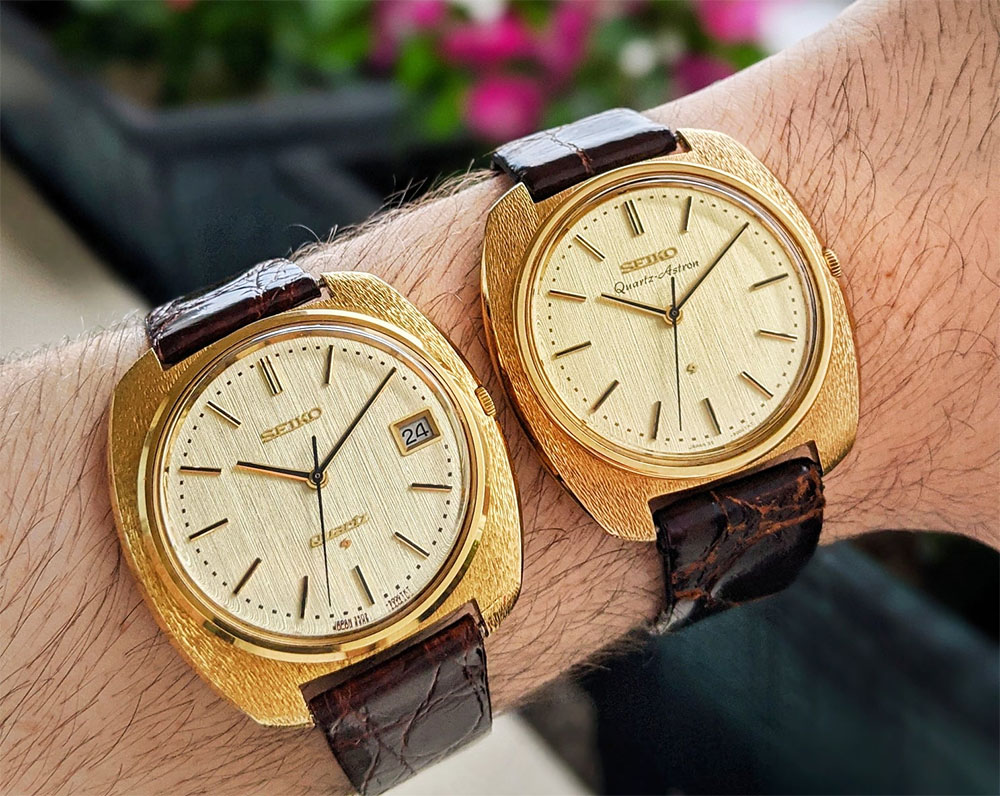
The Seiko Quartz-Astron debuted in Tokyo stores on December 25, 1969 as the world’s first commercial quartz wristwatch, with a luxurious 18-karat solid gold case, hand carved by skilled craftsmen.
It was priced at 450,000 yen (about 1,600,000 yen today adjusted for inflation). For comparison, of all the Grand Seiko appeared in the 1969 catalog, the most expensive sold at 195,000 yen with a solid 18-karat gold case, less than half of the Quartz-Astron’s price. Its price was also higher than that of the Toyota Corolla, Japan’s most popular car.
A few hundred pieces were produced between 1969 and 1970, which according to some sources sold rapidly despite the very high price.
The earliest specimens I found during my research were produced in November of 1969, while the latest were from June of 1970.
An amazing achievement
When the Quartz-Astron came out, the accuracy of wristwatches improved overnight from a few seconds per day to a few seconds per year. While the margin of error for standard mechanical watches was around ±20 seconds per day, the Astron was 100 times better with an incredible accuracy of ±0.2 seconds per day, or ±5 seconds per month.
It’s worth knowing that at the same time Seiko was also producing the world’s most accurate mechanical watch, the Grand Seiko V.F.A. (Very Fine Adjusted), which achieved the astonishing (for a mechanical movement of that era) guaranteed accuracy of ±1 minute per month, with every watch assembled and carefully regulated by the most talented watchmakers at Seiko. As the Grand Seiko website says, “a level unprecedented for any mechanical wristwatch”.
But the Quartz-Astron was a way bigger deal than any other timepiece, since it changed forever the entire world of horology, and not only that.
It took a decade of research to develop the Astron. In 1959 Seiko launched the “Project 59A” within the Research & Development laboratory of Suwa Seikosha in Nagano.
The property of a quartz crystal to vibrate at a fast and precise speed when an electrical current passes across it (a phenomenon called piezoelectricity), had been known since the discoveries of Pierre Curie towards the end of the 1800s, and different companies, including Seiko, had already succeeded in using this principle to measure time accurately. The problem was that quartz clocks were so big that almost an entire room was needed to fit them in.
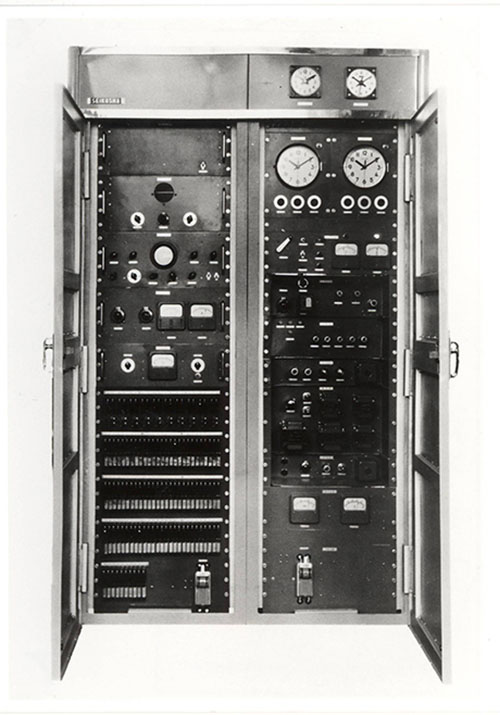
Image from the Seiko Museum of Tokyo.

Image from the Seiko Museum of Tokyo.
The main challenge for the development team, led by the brilliant mind of Tsuneya Nakamura, who later became chairman of Seiko Epson, was to miniaturize every necessary component to an extreme degree, since the size of the 1958 Seiko Quartz Clock was about 300,000 times that of a wristwatch.
Another big challenge was to greatly reduce the power consumption, in order to allow the watch to run for a decent period of time with a small battery.
A very important step towards the end goal was the development of the Crystal Chronometer, a portable quartz clock used during the 1964 Tokyo Olympic Games, where Seiko was the official timekeeper.
Although the advancements made with the Crystal Chronometer were already remarkable, there were still many problems to solve in order to scale down to the size of a wristwatch.
Towards the end of 1968, with the Swiss making progress on their own quartz projects, president Shoji Hattori ran out of patience and told his team that he wanted to achieve the release of a quartz watch within one year.
He put together a new team involving some of the most talented people available and asked them to work on design and prepare for production.
By the end of 1969 they were able to deliver a quartz movement that used a shockproof tuning fork oscillator, and an open-type step motor to convert electric signals into mechanical movements, while saving power by operating the hands by seconds.
Suitable integrated circuits were not available yet, so they had to rely on a hybrid circuit composed of many transistors, resistors and condensers, hand-soldered at 128 points. Doing this work by hand, on a movement so small, should have been incredibly difficult and required high skills, and this is probably the main reason why they only produced very few pieces per month.
Awards and acknowledgments
Thanks to the global recognition of the huge impact of the Quartz-Astron, Seiko has been honored with a number of prestigious awards.
In 2002, the Institute of Electrical and Electronics Engineers (IEEE), the world’s largest technical professional organization dedicated to advancing technology for the benefit of humanity, honored Seiko with the Corporate Innovation Recognition Award for the development of the first quartz watch.
In 2004, the Quartz-Astron was registered on the List of IEEE Milestones as a key achievement in electrical engineering.
Then, in 2014, it was certified as Mechanical Engineering Heritage by the Japan Society of Mechanical Engineers (JSME).
The myth of a 100 Limited Edition
In early January of 1970, soon after the release of the Quartz-Astron, then executive director Reijiro Hattori said that about 100 had been sold before the end of the year 1969. His statements were reported in an article in The New York Times published on January 5, 1970.
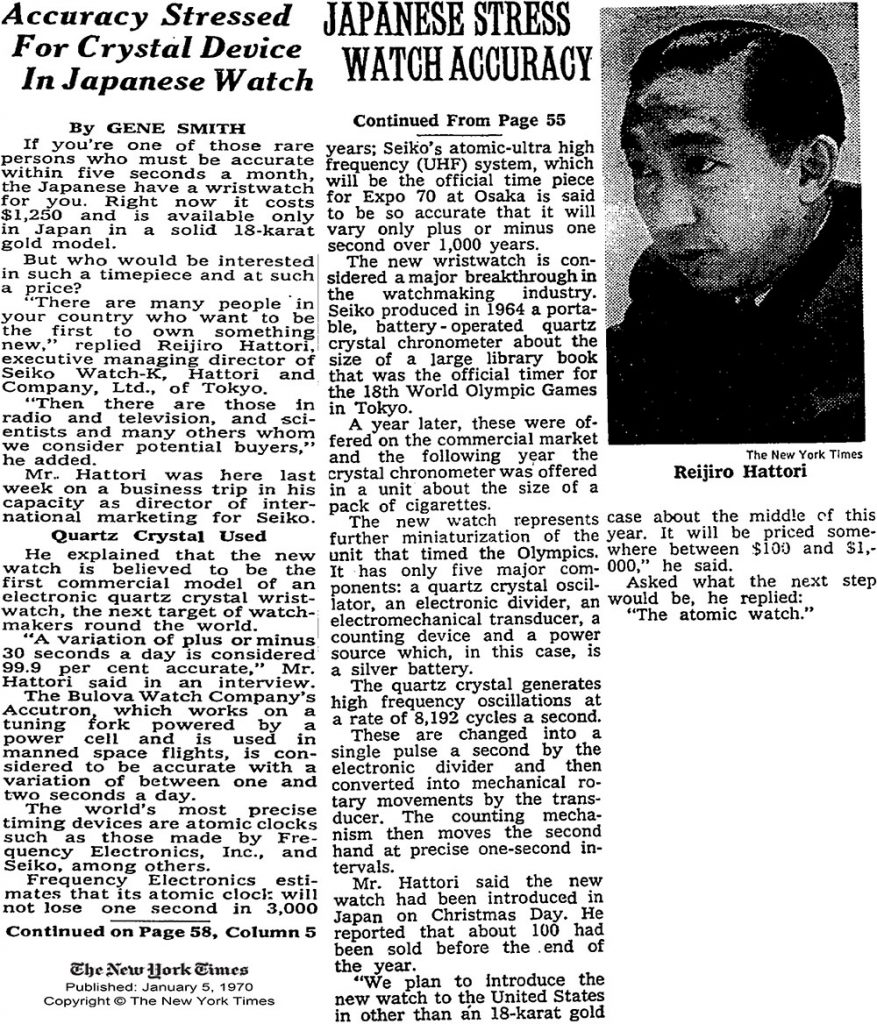
It is likely that, later on, somebody misinterpreted or mistranslated Mr. Hattori’s words, creating the myth of a 100 limited edition.
As a matter of fact, 100 was originally reported only as an approximation of the pieces sold in the week following the market launch. The Quartz-Astron 35SQ was never meant to be a limited edition, and although very few specimens exist, production of the first model continued until at least June of 1970.
The myth of a 100 limited edition became so widespread that apparently even people inside Seiko believed it in later years: the book A Journey in Time by John Goodall, which remains a highly valuable source of information on Seiko’s history, wrongly talks about a 100 pieces limited edition, and the same mistake is found in this official press release issued by Seiko in December 2009.
Although the 100 limited edition is, as we have seen, a myth spread erroneously by many publications, the fact remains that very few Quartz-Astrons have been produced, in the order of a few hundred.
For further information on this topic I reccommend reading “How many Astron watches were really produced?“.

Early models with gold case
The first quartz watch, produced from the end of 1969 and sold in Japan from December 25 of the same year, was characterized by the Quartz-Astron writing under the Seiko logo at 12 o’clock.
A short time later, a new model with date window, the 35SQC, was introduced to the market: produced from the beginning of 1970, it does not have the Quartz-Astron writing on the dial, but instead a Quartz logo positioned at 6 o’clock, above the small Suwa logo.
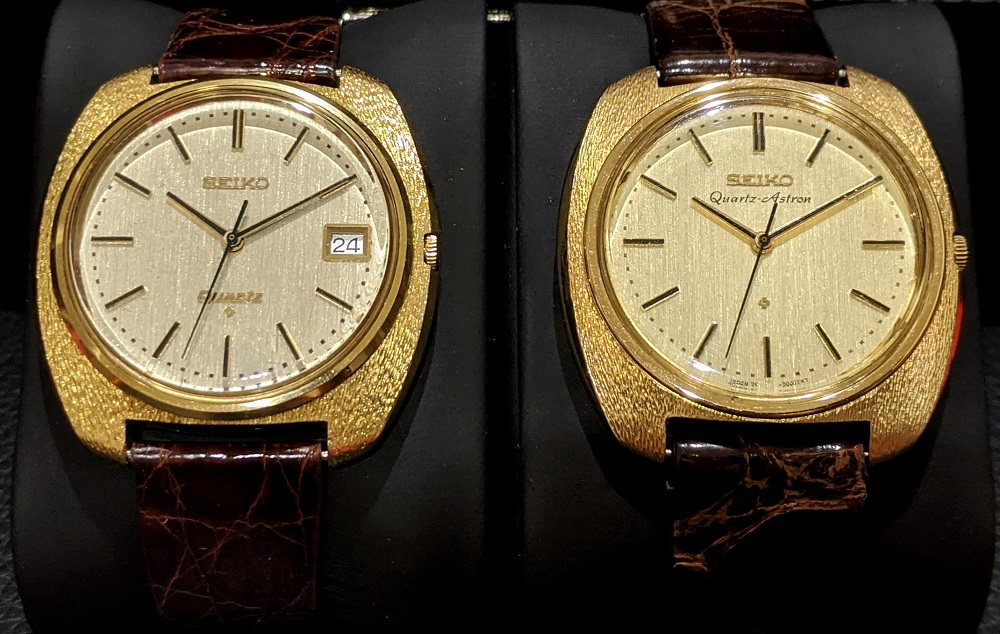
In 1970 a third variant of the gold Astron was also produced, which appeared in some Seiko publications of the time: a model with a dial very similar to that of the date version, with the Quartz logo at 6 o’clock. Although this version is seen in a few Japanese brochures, I believe it was intended for the foreign market.
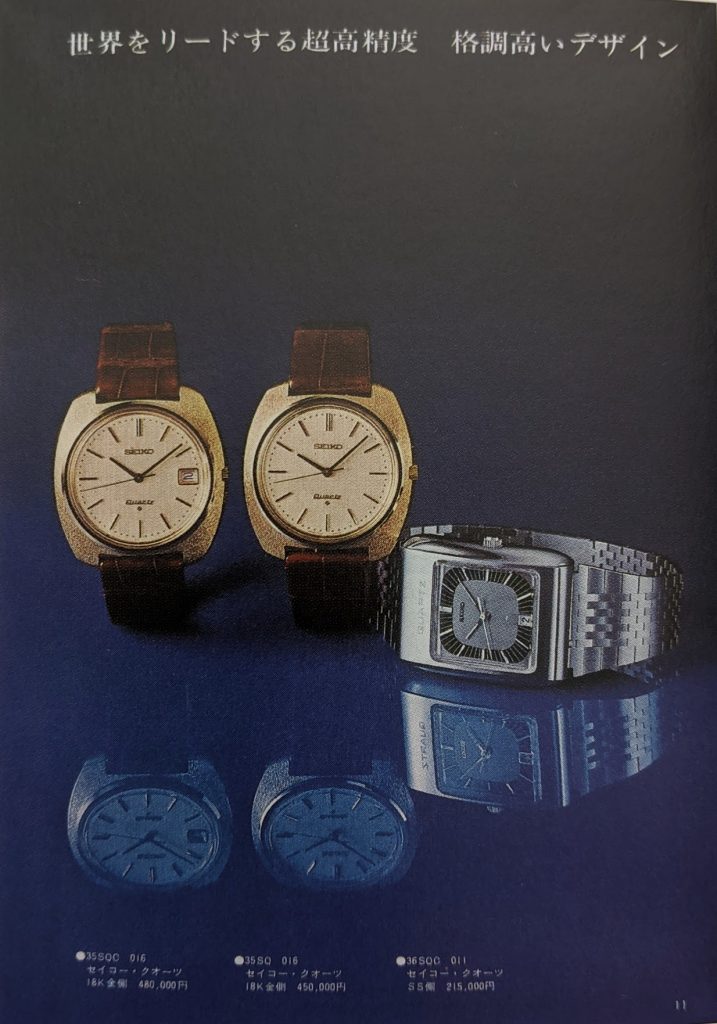
All of the gold Quartz-Astron models, with and without date window, had the inscription 35-9000 on the back of the case: 35 identified the caliber (also known as 35A or 3500) and 9000 identified the case.
Even if the date model also had 35-9000 written on the back, on the watch’s dial the movement is identified as 3502, in contrast to the 35 on the dial of the non-date Quartz-Astron.
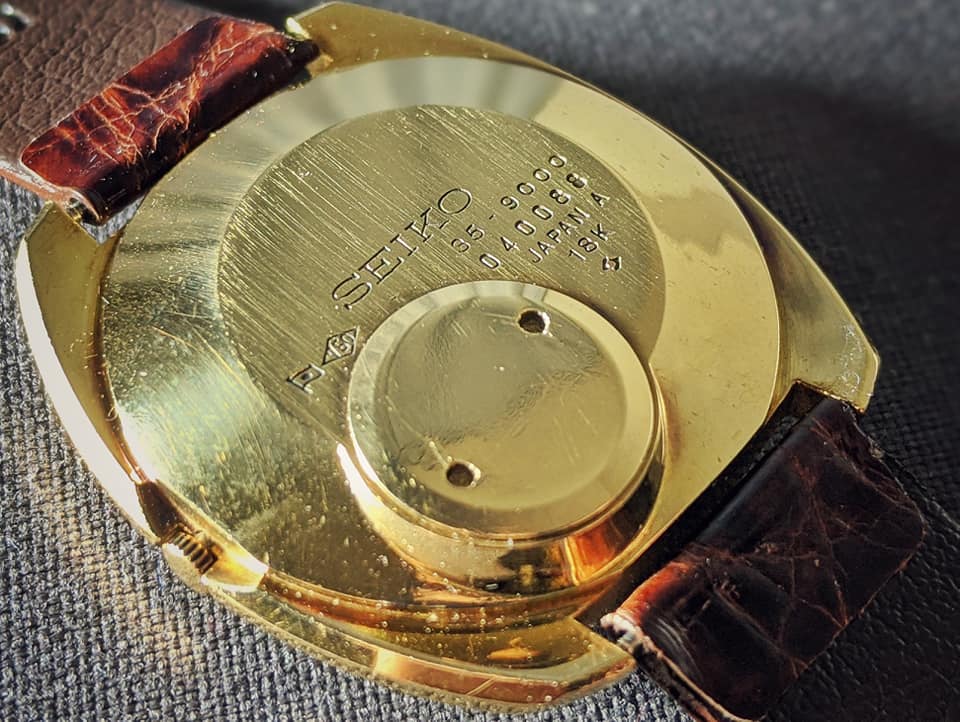
Quartz-Astron 35SQ (35-9000)
Produced from the end of 1969 (the earliest serials that I saw date back to November 1969), until the middle of 1970. It debuted in Tokyo stores on December 25, 1969. Probably sold exclusively in Japan.
Solid 18-karat gold case, “Quartz-Astron” writing under the Seiko logo at 12 o’clock.
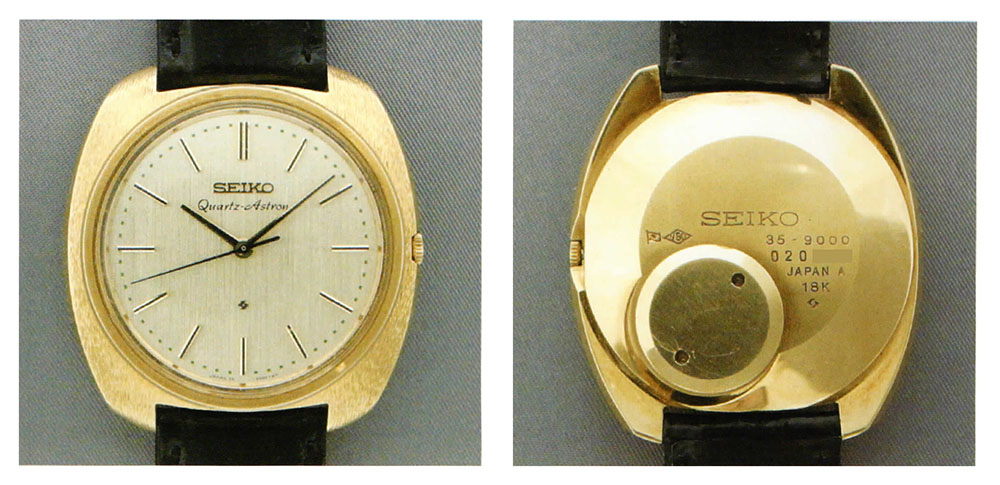
Quartz-Astron 35SQC (35-9000, sometimes referred to as 3502-9000)
Produced from early 1970, the 18-karat gold case appears to be the same as the first model, except for the gold bezel, which is slightly different between the two.
No “Quartz-Astron” written on the dial at 12 o’clock, replaced by the Quartz logo at 6 o’clock.
Probably sold both in Japan and in selected overseas markets.
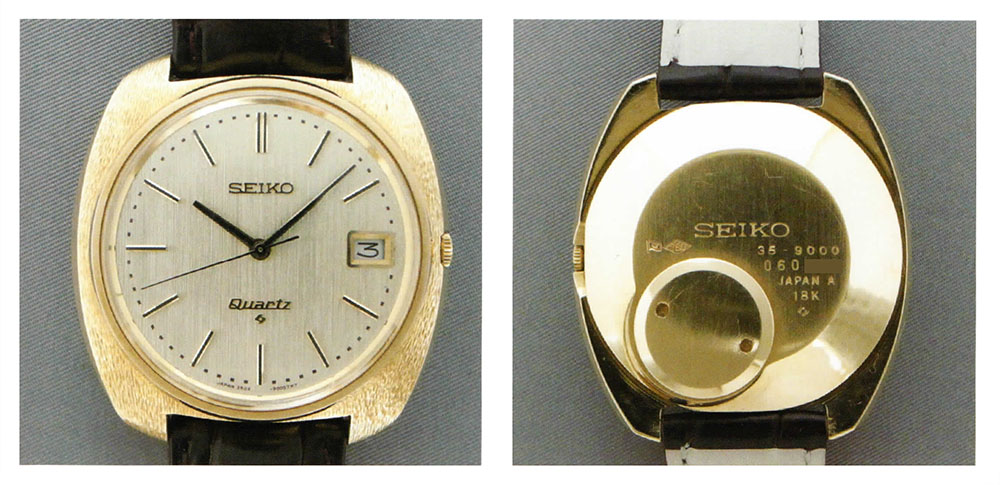
“Overseas” Quartz-Astron 35SQ (35-9000)
Produced from early 1970, 18-karat gold case like the previous models.
Quartz logo at 6 o’clock like the version with date window.
Probably sold only outside of Japan, in selected overseas markets.

“Mystery” Quartz-Astron 35SQ
There is a version of the Quartz-Astron with only the Seiko and Suwa logos on the dial, which had previously been exhibited at the Seiko Museum in Tokyo.
The same watch appeared in a photo published in the April 1971 issue of Playboy Magazine. Apparently this model has never been for sale.
I asked the Seiko Museum, where the watch was exhibited in the past, but they were unable to offer any additional information about it.
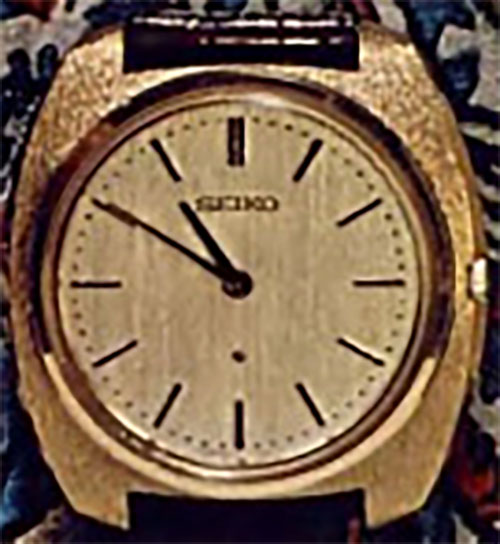
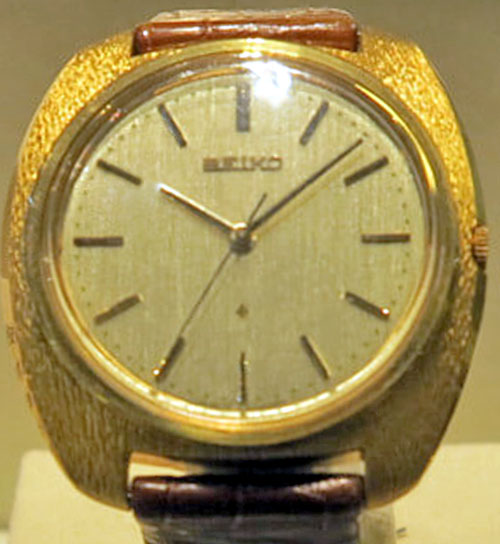
Looking closely at the gold Quartz-Astron 35SQ and the date version 35SQC, the main part of the case appears to be exactly the same, while the gold bezel is clearly different between the two models.
My guess is that it wasn’t just a stylistic choice. The bezel of the date model seems to make the watch case slightly taller, and it was probably necessary in order to fit the date version of the caliber, slightly thicker than the non-date 35A.
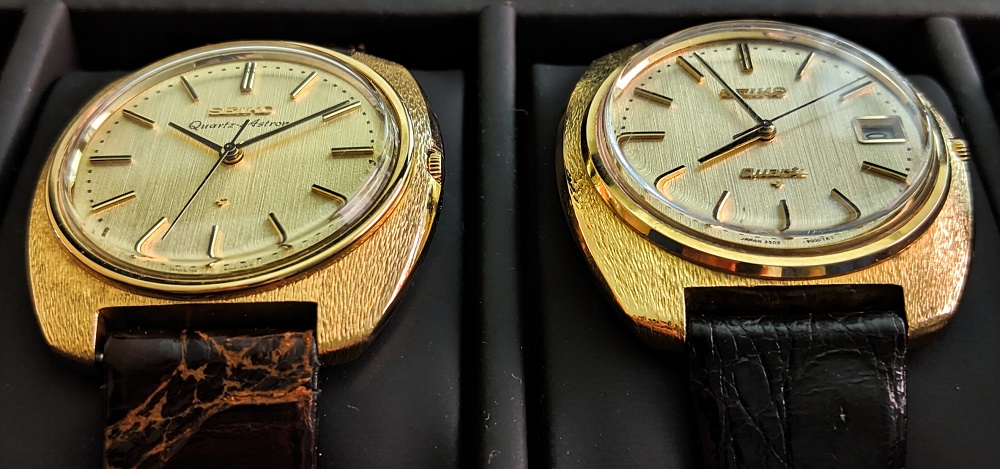
Later models with stainless steel case
Produced since the end of 1970, and introduced on the market in 1971, the two stainless steel models, also identified as 35SQ and 35SQC (SQ stood for Seiko Quartz and C for Calendar), present some important differences that go beyond design and materials.

The movement, although apparently the same caliber 35A as the previous gold cased models, hides a CMOS integrated circuit, with a frequency doubled to 16,384 Hz. This improved the accuracy of the watch to ± 0.1 seconds per day and ± 3 seconds per month.
These two new models were found on the opening pages of the 1972 Seiko Catalog. On the back of the case we find the reference 35-9010 on the model without date and 3502-9010 on the one with a date window.
Quartz-Astron 35SQ in stainless steel (35-9010)
Introduced in 1971 (based on the earliest serial numbers, production seems to have started at the end of 1970). Stainless steel case, Quartz logo at 6 o’clock.

Quartz-Astron 35SQC in stainless steel (3502-9010, version with date)
Introduced in 1971 together with the version without date. Stainless steel case and Quartz logo at 6 o’clock, like the model without date.

The evolution of the 35A caliber
Fitted inside the watch there was the 35A caliber, sometimes referred to as 3500, while on the caseback it was simply identified by the number 35. The date version of the caliber will later be identified as 3502A or 3502.
Along with a shockproof tuning fork quartz resonator, it used an open-type step motor which made the seconds hand move at only one step per second, a feature that almost all modern quartz watches have inherited.
In the gold cased models, the “35A” writing seems to always be present on the caliber, both on the models with and those without date, even thoug on the dial of the date model the movement was already referred to as 3502.
On the other hand, on the calibers found inside the stainless steel models later released, appears more clearly the distinction between those without date, still referred to as 35A, and those with date, on which the wording 3502A is found.
On all of the 35A and 3502A calibers there is a serial number distinct from the serial of the watch. It was not an uncommon practice for Seiko at that time to add a serial number on their more expensive high-end movements.
To analyze the evolution of the 35A caliber I have selected the following images that show three different versions.
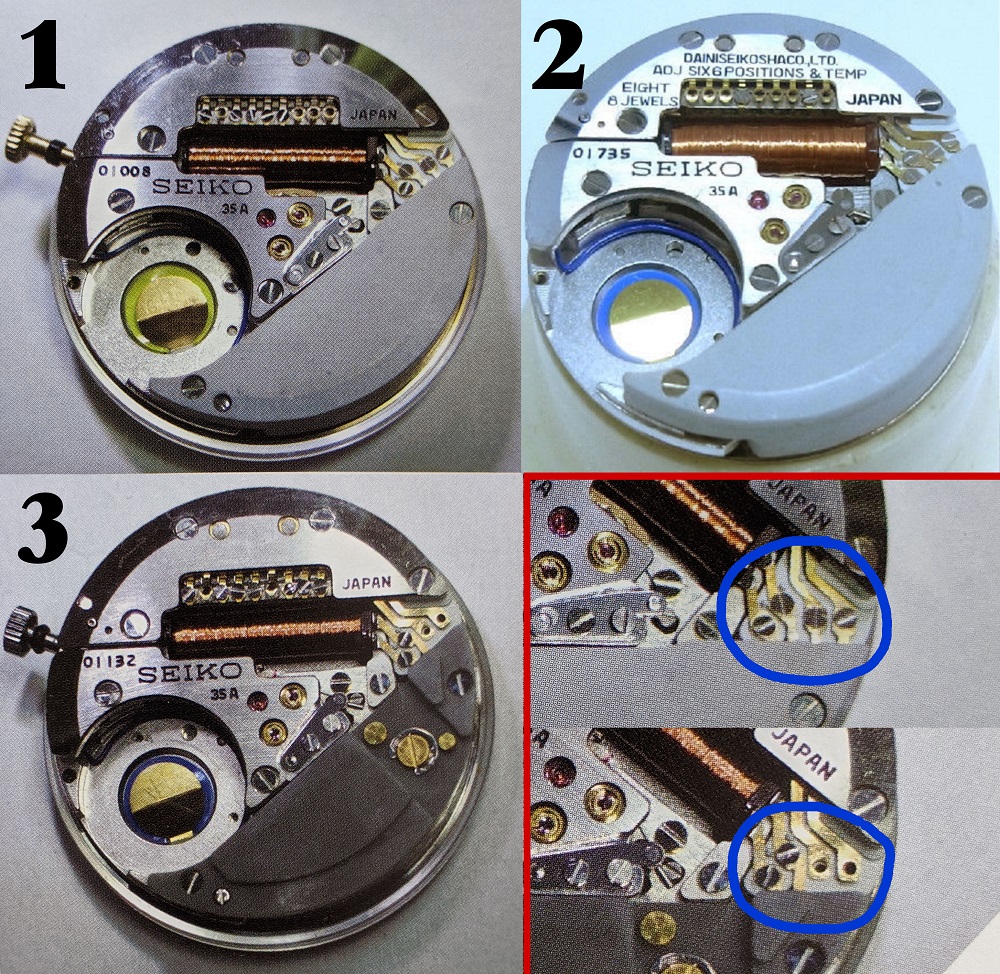
1) First version of the 35A caliber, with a hybrid integrated circuit and a quartz crystal frequency of 8,192 Hz. This is the caliber that was originally fitted into the gold cased Quartz-Astron.
2) The caliber fitted inside the stainless steel models released in 1971 is still the 35A (3502A for the date model), but the frequency has doubled to 16,384 Hz, thanks to a new integrated circuit.
It should be noted that this integrated circuit is interchangeable with the previous one present in the early 35A calibers. It is therefore possible to find early 35A calibers in which a non-functioning IC has been replaced with a different one.
3) The third 35A caliber in the picture has a more efficient integrated circuit, developed around 1990 by Seiko Epson. This IC was developed and produced in small numbers as replacement part, for the watches that were still sent for service. It runs at a frequency of 32,768Hz and is said to have improved performance, as it has been developed with newer technologies.
The screw that you can see, absent from the previous ICs, is used to regulate a trimmer condenser. In this version only two connections were used between the integrated circuit and the quartz oscillator.
Table of technical specifications:
| Caliber | 35A 3502A (with date) |
| Dimensions | Diameter 30 mm Thickness 5.30 mm (5.90 mm with date) |
| System of operation | Oscillation of the quartz crystal, stepper motor |
| Jewels | 8 |
| Crystal frequency | 8,192 Hz (first IC version) 16,384 Hz (second IC version) 32,768 Hz (third IC version) |
| Accuracy (+4°C ~ +36C) | ± 0.2 seconds per day, ± 5 seconds per month (8,192 Hz) ± 0.1 seconds per day, ± 3 seconds per month (16,384 Hz) No data available for the third version of the IC. |
| Battery life | 1 year or more Battery life was improved with the second and third versions of the integrated circuit. |
The Quartz-Astron brochure
Around the launch period of the Quartz-Astron, Seiko released a brochure that was intended to illustrate to buyers the features of the innovative watch, which for the time was a total novelty and whose extremely high price needed to be justified.
The full version of the brochure is available in the Seiko Catalogs archive.
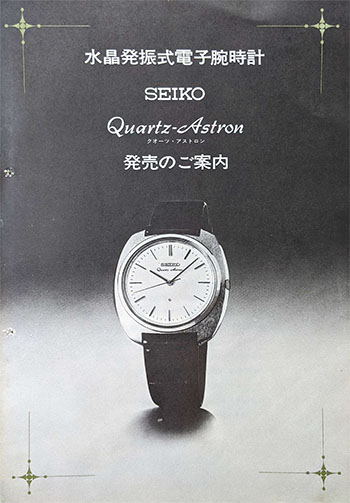
The brochure contains a wealth of information on the revolutionary precision of the watch and the new technologies used in the making of the caliber 35A.
The caliber specification table shows the original frequency of 8.192Hz.
Commemorative editions
Over the years Seiko has paid homage to its most important and iconic watch with various limited editions.
In the context of the Historical Collection of the year 2000, Seiko introduced a reissue of the Quartz-Astron 35SQ, in a limited edition of 500 pieces.
For this model the 9F61 caliber was used, fitted inside an 18-karat gold case very similar to that of the original Astron. The dial was also similar to the original, but without the Suwa logo at 6 o’clock.
The watch was sold at the list price of 700,000 yen with the reference SCQZ002 (9F61-0A50).
ATTENTION: I have seen this watch at auction on a couple of occasions, described as Quartz-Astron 35SQ, without specifying that it is the 2000 commemorative edition.
The original Quartz-Astron, the model launched at the end of 1969 and produced for a few months until the middle of 1970, is extremely rare and has a much higher value.
Pay attention to differences, such as the Suwa logo at 6 o’clock (absent on the dial of the 2000 commemorative edition) and the back of the watch.
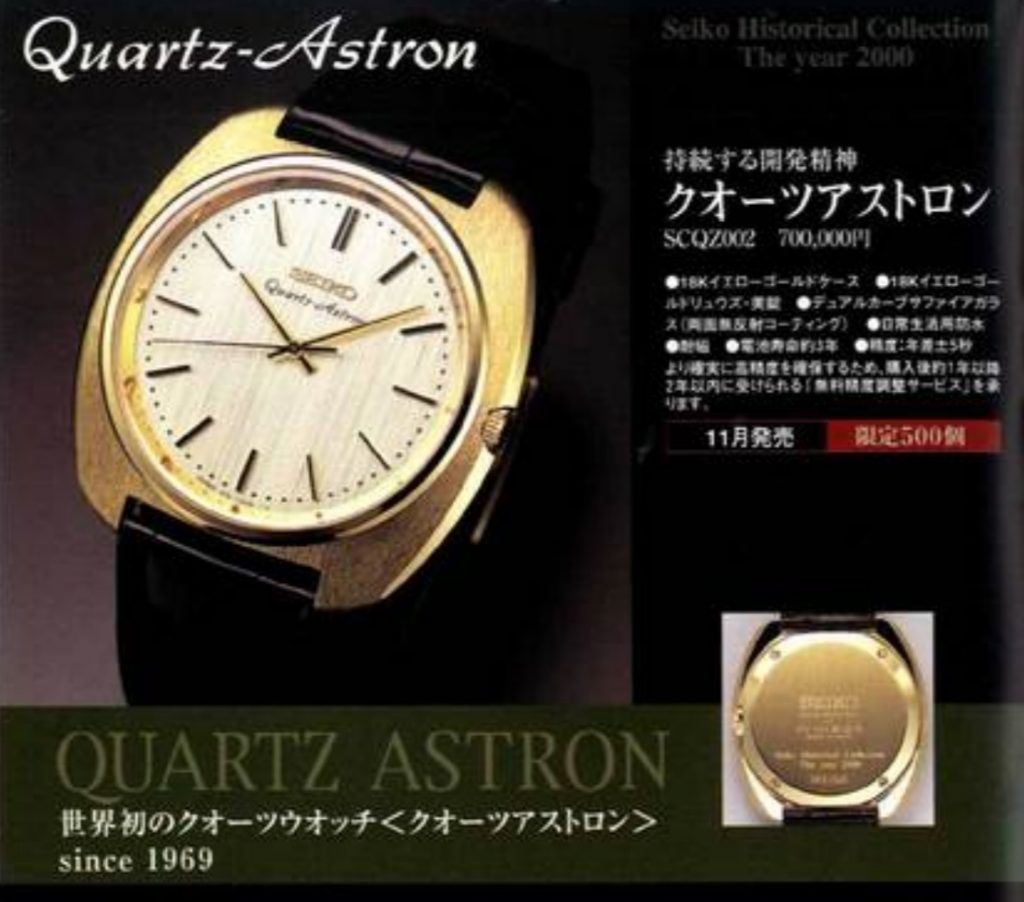
In 2010, the year following the 40th anniversary of the Astron, Seiko releases a new commemorative edition limited to 200 pieces, with caliber 9F62 and reference S23617J1 (9F62-0AD0).
This time, important changes were made to the design and materials, starting with the titanium case and the dark dial that reveals a motif composed of the logo used in the past by Seiko for its quartz watches.
You can read the presentation of the watch in this March 2010 press release .
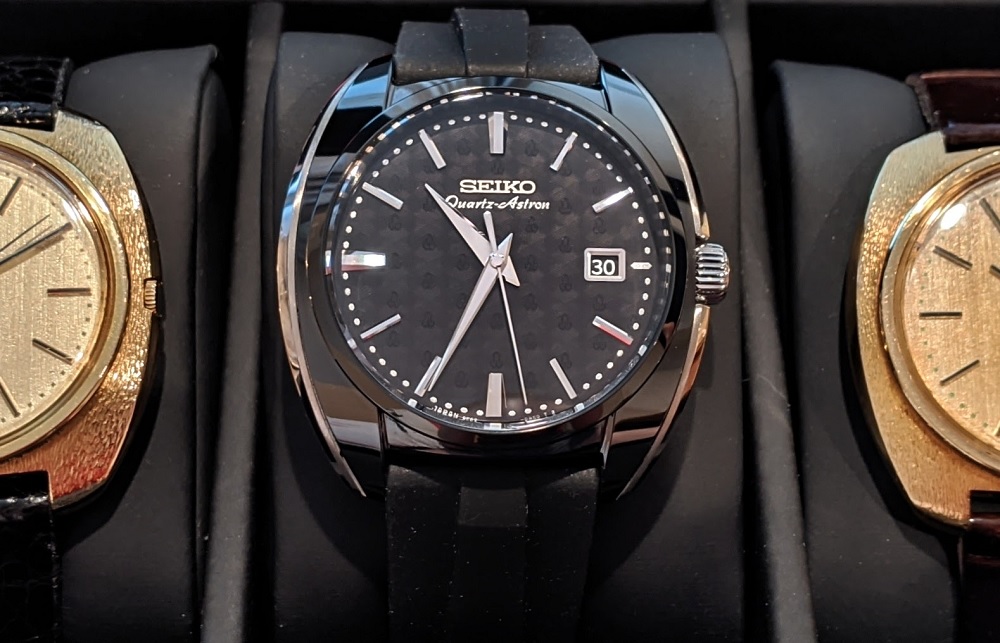
For the 50th anniversary in 2019 Seiko presented “The 1969 Quartz Astron 50th Anniversary Limited Edition”, a model that combines the technology of the new Astron GPS Solar with a design strongly evocative of the 1969’s first quartz watch.
We find an elegant 18-karat solid gold case, hand-carved by expert craftsmen, which this time houses the caliber 3X22, the thinnest solar GPS caliber in the world at the time of release.
By automatically adjusting the time twice a day via the GPS network, the watch declares an accuracy of one second every 100,000 years.
Limited to just 50 pieces, this commemorative edition with reference SBXD002 (3X22-0AB0), was sold in selected Seiko boutiques at a price of 3,800,000 yen in Japan, 38,000 euros in Europe.
